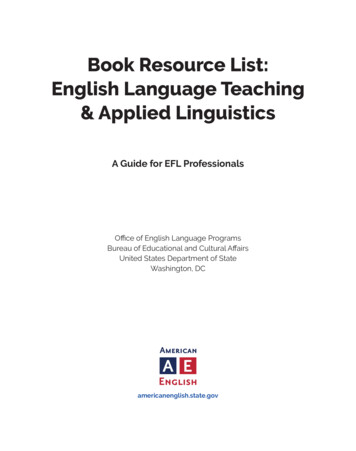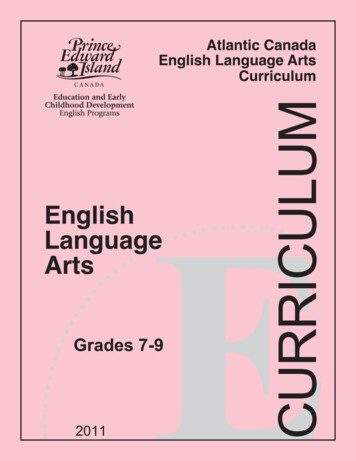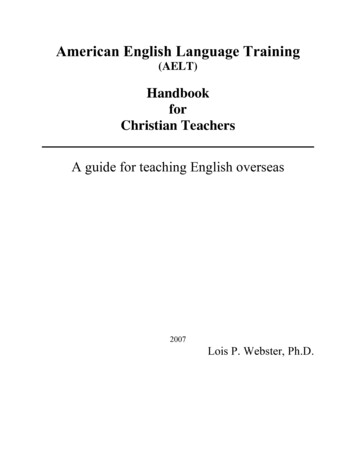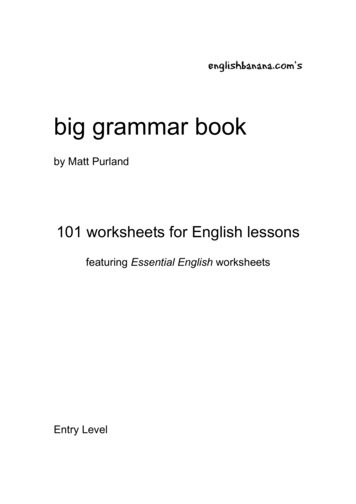
Transcription
Book Resource List:English Language Teaching& Applied LinguisticsA Guide for EFL ProfessionalsOffice of English Language ProgramsBureau of Educational and Cultural AffairsUnited States Department of StateWashington, DCamericanenglish.state.gov20-21666 Book Resource List English Language Teaching & Applied Linguistics.indd 12/10/21 6:51 AM
INTRODUCTIONThe book resource list that follows was originally developed to support English LanguageFellows, English Language Specialists, and Regional English Language Officers inidentifying resources that will aid them in completing projects sponsored by the Office ofEnglish Language Programs, Bureau of Educational and Cultural Affairs, U.S. Departmentof State. However, this resource may be of interest to any English language teachingprofessional working in an English as a foreign language (EFL) context.The focus is largely on books, rather than journals or articles, that have been publishedin the past five years, along with some older titles that are still considered particularlyrelevant. Based on input from a small group of individuals, this bibliography will naturallybe limited in scope due to personal interests, experience, and knowledge, among otherfactors. There are many other worthwhile publications that, in a larger collection, wouldcertainly be considered vital additions and should not be overlooked.The bibliography is in two parts: Part One focuses on Educating Language Learners in the primary language skills(speaking, listening, reading, writing, grammar, vocabulary, and pronunciation) and alsohas sections focusing on technology, culture, young learners, and English for AcademicPurposes. The section on integrated skills is not extensive, but this should not beunderstood as a lack of support for the approach. We fully support and recommend thisapproach in most contexts. For more information, see the Integrated Skills section. Eachsection in Part One is divided into Teacher References and Teaching Materials for usewith English language learners. Teaching materials may include activity sourcebooks,textbooks, or reference books like dictionaries. Assessment of language skills isaddressed in Part Two, Chapter 15. Part Two focuses on Educating Teachers in TESOL-content areas from curriculumdesign to second language acquisition, assessment, action research, programadministration, and beyond. Naturally, these sections are devoted entirely to TeacherReferences, including those focused on helping teachers assess the language skillslisted in Part One. Chapter 13: Teaching Methodology includes titles related to thetheories underlying teaching methodology, methodological practices, Content-BasedInstruction (CBI), classroom management, and more.Each entry is labeled according to the categories and symbols below for quick hly recommendedElectronic bookEnglish for Specific PurposesRelevant to K–12 teachersHardback or paperback bookMultimedia: including audio CD or DVDMulti-level seriesCompanion website220-21666 Book Resource List English Language Teaching & Applied Linguistics.indd 22/10/21 6:51 AM
Table of ContentsPART ONE: Educating Language Learners. 41.2.3.4.5.6.7.8.9.10.11.12.Integrated Skills . 5Speaking . 7Listening .10Reading . 12Writing .14Grammar .16Vocabulary .18Pronunciation . 21Technology .23Culture .25Young Learners .27English for Academic Purposes . 29PART TWO: Educating Teachers.3013. Teaching Methodology. 31 Theory and Methodology. 31 Methodology in Practice. 31 General Teaching Methodology. 32 Content-Based Instruction (CBI) . 33 Classroom Management. 34 Miscellaneous . 3514. Curriculum & Materials Development. 3615. Language Assessment.3716. Second Language Acquisition.4017. Teacher Training.4118. Linguistics. 4319. Research Methods. 45Acknowledgements.46320-21666 Book Resource List English Language Teaching & Applied Linguistics.indd 32/10/21 6:51 AM
PART ONEEducating Language Learners420-21666 Book Resource List English Language Teaching & Applied Linguistics.indd 42/10/21 6:51 AM
1. INTEGRATED SKILLSThis section on integrated skills is not extensive. This is because an integrated-skillsapproach has become the standard approach to teaching English in most contexts andmost modern general coursebooks are integrated skills. This common usage is probablywhy we could identify no teacher references that focus on integrated skills from atheoretical perspective, or activity sourcebooks. The lack of teacher references in thissection should not be interpreted as a lack of support for integrated skills. We fully supportand recommend this approach in most contexts.We recognize that there are many excellent integrated skills coursebooks on the marketand we could not possibly list them all. We list a very limited selection of popular textsbelow. It is important to note that these coursebooks are designed for internationalmarkets. There may be integrated skills coursebooks designed for particular regions, firstlanguages, or countries that are more appropriate for your context.TextbooksFoley, B. H. & Neblett, E. R. (2018). English in action! (3rd ed.). Boston, MA: Heinle ELT.This four-level series focuses on building language, life, and career skills through roleplaying communicative activities. Chapters include grammar and vocabulary practice aswell as activities focused on solving real-world problems and cooperative learning andclassroom community-building activities.printMMserieswebsiteKay, S. & Jones, V. (2017). New American inside out. London, UK: Macmillan Education.This six-level series takes students from beginner to advanced levels. Units includevocabulary, grammar, pronunciation input, and practice sections, as well as four skillspractice; however, the focus is on preparing students for fluency speaking. A CD is includedwith each student’s book. The series has online practice and workbooks, as well asteachers’ books that guide teachers through teaching procedures that they may not befully familiar with.printMMserieswebsiteRichards, J., Hull, J. & Proctor, S. Interchange (5th ed.). Cambridge, UK: Cambridge UniversityPress.This long-established four-level series takes adult learners from beginning to intermediatelevels. Units include grammar, vocabulary, and pronunciation focus sections, and oftenbuild up to dialogues that can be personalized. The book includes interactive pair-workactivities, a grammar reference section, and a list of new vocabulary items. The latesteditions provide access to online self-study and workbooks. Earlier editions, accompaniedby print workbooks, may be more appropriate for some contexts. The series has clearteachers’ guides, which include an assessment section.printserieswebsite520-21666 Book Resource List English Language Teaching & Applied Linguistics.indd 52/10/21 6:51 AM
Soars, J. & Soars, L. (2016). American headway (3rd ed.). Oxford, UK: Oxford University Press.This long-established six-level general English series is aimed at learners from beginningto advanced levels. The books follow a robust vocabulary and grammar syllabus andprovide plenty of speaking practice. The series includes teachers’ books, online activities,and online self-assessment resources.printserieswebsiteStephenson, H., Dummet, P., Bohlke, D., Lansford, L., & Walker, R. Keynote. NationalGeographic Learning.This series uses TED Talks to explore inspiring stories and develop communication,collaboration, creativity, and critical thinking skills. Authentic readings, infographics, andinterviews add context, content, and practice. Students develop fluency, confidence, anddelivery as presenters through analyzing TED speakers.printMMserieswebsite620-21666 Book Resource List English Language Teaching & Applied Linguistics.indd 62/10/21 6:51 AM
2. SPEAKINGTeacher ReferencesBleistein, T., Smith, M., & Lewis, M. (2020). Teaching speaking, revised. Alexandria, VA:TESOL Press.ISBN: 9781945351921This book introduces strategies for teaching and assessing speaking communicatively andexplores language in real-world conversational contexts.eBook printHughes, R. & Reed, B. (2017). Teaching and researching speaking (3rd ed.). New York, NY:Routledge.ISBN: 9781138911741This book provides an overview of language theory, the nature of speaking, attitudes tospoken forms, and relationships between written and spoken forms. The text includes afocus on approaches to researching, teaching, and assessing spoken language, as wellas conversation analysis, teaching materials, and oral assessment with attention to onlinecorpora and mobile applications. It is relevant to both language teachers and teachereducators.***eBook printNation, I. S. P. & Newton, J. (2020). Teaching ESL/EFL listening and speaking (2nd ed.). NewYork, NY: Routledge.See CHAPTER 3: LISTENINGThornbury, S. (2005). How to teach speaking. Hoboken, NJ: Pearson Education ESL.ISBN: 9780582853591This book is an introduction to approaches and activities for teaching and testingspeaking. It addresses topics such as fluency, articulation, and register and considers avariety of techniques and activities including drilling, discussions, drama, dialogues, andconversation. The text includes a collection of practical exercises and activities and asuggested reading list.***printTeaching MaterialsActivity SourcebooksBilbrough, N. (2007). Dialogue activities: Exploring spoken interaction in the languageclass. Cambridge, UK: Cambridge University Press.ISBN: 9780521689519This book is a guide to using dialogues in language classrooms and includes more than100 adaptable activities that explore English through dialogues. The text includes a focus720-21666 Book Resource List English Language Teaching & Applied Linguistics.indd 72/10/21 6:51 AM
on dialogues as both product and process in language teaching and supports learners ingoing beyond conventional communicative strategies to practice speaking language innew ways.printKlippel, F. (1985). Keep talking: Communicative fluency activities for language teaching.New York, NY: Cambridge University Press.ISBN: 9780521278713This book has over 100 fluency speaking activities for beginning to advanced-levelstudents, including interviews, guessing games, jigsaw tasks, role-plays, and storytelling,problem-solving, and values clarification activities. Reproducible worksheets are included.***printUr, P. (2014). Discussions and more (2nd ed.). Cambridge, UK: Cambridge University Press.ISBN: 9781107442757This latest edition of the classic text Discussions that Work has instructions for over 50speaking activities, including games, presentations, and debates. The book has three parts:Simpler, Shorter Activities; Activities of Medium Length and Complexity; and Longer andMore Challenging Activities. Each activity can be modified for use with different languagelevels and ages.***printK–12Vorholt, J. (2018). New ways in teaching speaking (2nd ed.). Alexandria, VA: TESOL Press.ISBN: 9781945351280This book is a collection of adaptable speaking activities for a wide range of ages andlevels. The text has collections of activities that focus on fluency, accuracy, pronunciation,and a number of specific contexts, as well as an extensive section on using technology toimprove speaking skills. A companion website has teacher resources, including rubrics andhandouts.printwebsiteTextbooksHitsky, D. (2011). Surveys for conversation (2nd ed.). Brattleboro, VT: Pro Lingua Associates.ISBN: 9780866473224This book is a collection of photocopiable questionnaires aimed at the high-beginner tohigh-intermediate levels. Each worksheet is designed to be used over two days. Topicsare introduced on the first day and surveys assigned for homework. On the second day,completed surveys are the basis for conversation.printJones, L. (2007). Let’s talk (2nd ed.). Cambridge, UK: Cambridge University Press.This three-text series takes students from high-beginning to high-intermediate level. Theseries focuses on oral communication skills and developing fluency speaking and listeningactivities. Unit themes focus on high-frequency topics such as food and cooking, weather,820-21666 Book Resource List English Language Teaching & Applied Linguistics.indd 82/10/21 6:51 AM
sports, etc. Each text includes a self-study section that with listening, vocabulary, andgrammar practice. The books have an accompanying audio CD.printMMseriesPowell, M. (1996). Presenting in English. Boston, MA: Heinle ELT.ISBN: 9781111832278This book has brief overviews of, and exercises for, practicing speaking strategiesfor business presentations. Many of the strategies, such as softening, emphasis, andsignposting, are relevant in a variety of academic or professional contexts.printMMESPSee Also:Chapter 1: Integrated SkillsChapter 8: PronunciationChapter 10: CultureChapter 15: Language Assessment920-21666 Book Resource List English Language Teaching & Applied Linguistics.indd 92/10/21 6:51 AM
3. LISTENINGTeacher ReferencesLynch, T. (2009). Teaching second language listening. Oxford, UK: Oxford University Press.ISBN: 9780194423342This book provides guidance on adapting, creating, and evaluating listening tasks.It includes sections on background issues in listening, listening processes, teachingsecond-language listening, and learning second-language listening. It also containsmaterial on self-study, learner-centered listening, collaborative listening, and bringing theworld into the classroom.printNation, I. S. P. & Newton, J. (2020). Teaching ESL/EFL listening and speaking (2nd ed.). NewYork, NY: Routledge.ISBN: 9780367195533This text deals with a listening/speaking program and addresses Nation’s four strandsin this context: meaning-focused input, meaning-focused output, language-focusedlearning, and fluency development. Similar to the companion text above on readingand writing, it assumes no previous experience with Second Language Acquisition (SLA)theory or applied linguistics and suggests teaching, learning, and assessment strategiesfor use across proficiency levels. Teachers may want to supplement this with a referencethat more thoroughly examines the areas of pronunciation, lesson planning, andassessment.printeBookNemtchinova, E. (2020). Teaching listening, revised. Alexandria, VA: TESOL Press.ISBN: 9781945351808This book presents research and theory related to second language listening, andclassroom applications. It includes a focus on listening, listening skills and strategies, andhow to teach listening.eBook printRichards, J. & Burns, A. (2011). Tips for teaching listening: A practical approach. Hoboken,NJ: Pearson Education ESL.ISBN: 9780132314831This book is an introduction to research on teaching listening as well as specific teachingtechniques. The authors address listening skills and processes, text types, course planningand assessment, and academic listening.printRost, M. (2015). Teaching and researching listening (3rd ed.). New York, NY: Routledge.ISBN: 9781138840386This book provides a summary of teaching and researching listening and includes a focus1020-21666 Book Resource List English Language Teaching & Applied Linguistics.indd 102/10/21 6:51 AM
on (a) the neurological, linguistic, pragmatic, and psycholinguistic processing involved inlistening, and first- and second-language listening; (b) approaches, methods, instructionaldesign, and assessment; and (c) research methods and sample research projects, includingprocedural guidelines.***eBook printTeaching MaterialsActivity SourcebooksHadfield, J. & Hadfield, C. (2000). Simple listening activities. Oxford, UK: Oxford UniversityPress.ISBN: 9780194421683Part of the Oxford Basics series, this book is designed for inexperienced teachers and hassimple, clear instructions for short, communicative listening activities at the beginning levelthat are suitable for low-resource environments. Note: The book uses British English.printK–12TextbooksSarosy, P. & Sherak, K. (2013). Lecture ready: Strategies for academic listening andspeaking – Student Book 1 (2nd ed.). Oxford, UK: Oxford University Press.This is a three-part series aimed toward mid-intermediate to advanced-level students.The texts expose learners to sample lectures and provide practice in note-taking andacademic discussions. The series has extensive online resources for teachers.printMMserieswebsiteSee Also:Chapter 1: Integrated SkillsChapter 2: SpeakingChapter 15: Language Assessment1120-21666 Book Resource List English Language Teaching & Applied Linguistics.indd 112/10/21 6:51 AM
4. READINGTeacher ReferencesDay, R. (2020). Teaching reading, revised. Alexandria, VA: TESOL Press.ISBN: 9781945351785This book explores reading, reading strategies, reading fluency, reading comprehension,and reading objectives and includes strategies for teaching reading based on theinteractive processes students experience when learning to read.eBook printGrabe, W. (2009). Reading in a second language: Moving from theory to practice. NewYork, NY: Cambridge University Press.ISBN: 9780521729741This book is a scholarly introduction to theories and practical applications of L2 reading.Topics include basic reading processes, individual learner differences, social contexts ofreading, vocabulary and grammar development, discourse structure, learner strategies,comparisons of first- and second-language reading, fluency and extensive reading, therelationship between reading and writing, and reading assessment. The book connectsthese notions to classroom applications as well as curriculum design.eBook printHedgcock, J., & Ferris, D. (2018). Teaching readers of English: Students, texts, and contexts(2nd ed.). New York, NY: Routledge.ISBN: 9781138206212This book is an introduction to second language reading and literacy at secondary andhigher levels. Topics include definitions of literacy, writing systems, and a discussion ofreaders and texts. Also addressed are vocabulary development, close and extensivereading, and assessment.eBook printNation, I. S. P. & Macalister, J. (2020). Teaching ESL/EFL reading and writing (2nd ed.). NewYork, NY: Routledge.ISBN: 9780367433765This book is aimed at those with no prior experience with Second Language Acquisition(SLA) theory or background in applied linguistics and would be helpful to novice teachersin designing a reading and writing course. The text introduces four strands of languageacquisition in relation to reading and writing: meaning-focused input, meaning-focusedoutput, language-focused learning, and fluency development. It also suggests teaching,learning, and assessment strategies for use across proficiency levels. The text does notaddress the latest research on whole-language approaches to reading or the role ofphonics in teaching reading, and therefore, other resources would be helpful for guidinglesson planning and assessment.printeBook1220-21666 Book Resource List English Language Teaching & Applied Linguistics.indd 122/10/21 6:51 AM
Teaching MaterialsActivity SourcebooksGrellet, F. (1981). Developing reading skills: A practical guide to reading comprehensionexercises. Cambridge, UK: Cambridge University Press.ISBN: 9780521283649This book is an overview and classification of the types of activities that develop readingskills. Although originally published in the 1980s, there has been nothing comparablepublished since to replace it. The book offers descriptions of activities for developingdifferent reading skills.printTextbooksZimmerman, C., Burgmeier, A., Richmond, K., Rubin, K., & Zwier, L. J. (2012). Inside reading(2nd ed.). Oxford, UK: Oxford University Press.This five-text series is aimed at beginning to advanced-level students. The texts preparelearners to read effectively in academic contexts and acquire key vocabulary from theAcademic Word List. The series has extensive online resources for teachers. Units includematerial and tasks from academic content areas and support learners in developingrelevant reading skills.printseriesSee Also:Chapter 1: Integrated SkillsChapter 15: Language Assessment1320-21666 Book Resource List English Language Teaching & Applied Linguistics.indd 132/10/21 6:51 AM
5. WRITINGTeacher ReferencesFerris, D. (2003). Response to student writing: Implications for second language students.Mahwah, NJ: Lawrence Erlbaum Associates.ISBN: 9780805836578This book focuses on feedback on L2 writing. The author discusses teacher error correctionand feedback, peer response, learners’ views on writing response, effective feedback,and further things to consider. The book provides authentic student writing and feedbacksamples, a training sequence for teachers on responding to writing, guidelines forteacher–student writing conferences, and suggestions on error correction procedures andimplementing peer response.***eBook printHinkel, E. (2015). Effective curriculum for teaching L2 writing: Principles and techniques.New York, NY: Routledge.ISBN: 9780415889995This book is a reference for prospective and practicing teachers of academic, college-levelwriting. Largely focused on preparing learners as academic writers in U.S. universities, thechecklists, discussion points, and classroom activities can be adapted for an EFL context.eBook printNation, I. S. P. & Macalister, J. (2020). Teaching ESL/EFL reading and writing (2nd ed.). NewYork, NY: Routledge.See CHAPTER 4: READINGPaltridge, B., Harbon, L., Hirsh, D., Shen, H., Stevenson, M., Phakiti, A., & Woodrow, L. (2009).Teaching academic writing: An introduction for teachers of second language writers.Ann Arbor, MI: University of Michigan Press/ESL.ISBN: 9780472033348This book introduces issues, processes, and teaching methodologies relevant toL2 writing for academic purposes. Topics include: processes, skills, strategies, andbackground knowledge in L2 writing; needs analysis in course design; EAP approachesand perspectives; vocabulary instruction, diagnostics, and the Academic Word List; crosscultural issues and first-language writing conventions; feedback methods; and assessmentprocedures. The book provides discussion questions and sample exercises and suggeststeaching implications.***printTomas, Z., Kostka, I., & Mott-Smith, J. (2020). Teaching writing, revised. Alexandria, VA: TESOL Press.ISBN: 9781945351860This book explores concepts in teaching writing, including planning, text-based writing,writing strategies, modeling, and responding to student writing, and encourages readers to1420-21666 Book Resource List English Language Teaching & Applied Linguistics.indd 142/10/21 6:51 AM
adapt the authors’ ideas to their own teaching contexts. The book includes lesson-planningguidance that encourages teachers to consider purpose and audience in developingwriting assignments.eBook printTeaching MaterialsActivity SourcebooksHadfield, J. & Hadfield, C. (2000). Simple writing activities. Oxford, UK: Oxford UniversityPress.ISBN: 9780194421706Part of the Oxford Basics series, this book has simple, clear instructions for shortcommunicative writing activities at the beginning level that are suitable for low-resourceenvironments. Note: The book uses British English.printK–12Mussman, D. C. (2013). New ways in teaching writing, revised. Alexandria, VA: TESOL Press.ISBN: 9781942223160This book has activities designed for a variety of contexts, including low-resourceclassrooms, K–12, and higher education. Some activities include the use of technology.printK–12TextbooksFerris, D. (2014). Language power: Tutorials for writers. London, UK: Macmillan Education.ISBN: 9780312577803This book has 25 tutorials for students focusing on strategies for improving vocabularyuse, grammar, and style in writing, as well as diagnostic activities to identify strengths andareas for improvement. The text might be used for self-access activities, as part of a writinglesson or in tutorials. Although many of the activities seem designed for the U.S. classroom,these could be adapted for EFL contexts.printLane, J. & Lange, E. (2012). Writing clearly: Grammar for editing (3rd ed.). Boston, MA: Heinle.ISBN: 9781111351977This book supports high-intermediate to advanced-level writers in becoming effective selfeditors and is organized around areas that are typically problematic for L2 writers. The bookincludes writing assignments designed for practice of each grammar area.printSee Also:Chapter 1: Integrated SkillsChapter 15: Language Assessment1520-21666 Book Resource List English Language Teaching & Applied Linguistics.indd 152/10/21 6:51 AM
6. GRAMMARTeacher ReferencesBiber, D., Conrad, S., Johansson, S., Leech, G., & Finegan, E. (1999). Longman grammar ofspoken and written English. Essex, England: Pearson Longman ELT.ISBN: 9780582237254This book is a corpus-based reference grammar of English and provides descriptivistexplanations of grammar in a variety of contexts, such as conversation, fiction, newsreportage, and academic prose. A student version and workbook are also available.printCrawford, W. J. (2020). Teaching grammar, revised. Alexandria, VA: TESOL Press.ISBN: 9781945351822This text focuses on developing teachers’ knowledge of grammar as well as strategies tohelp students use grammar. Readers are invited to reflect on their teaching practice andalso learn about corpus linguistics and concepts in grammar research.eBook printLarsen-Freeman, D. & Celce-Murcia, M. (2016). The grammar book: Form, meaning and usefor English language teachers (3rd ed.). Boston, MA: Heinle ELT.ISBN: 9781111351861This text is a comprehensive reference and includes grammar explanations and examples,as well as semantic and syntactic information. The book discusses theoretical perspectiveson teaching grammar along with teaching ideas, practice exercises, and readingsuggestions.***printSwan, M. (2016). Practical English usage (4th ed.). Oxford, UK: Oxford University Press.ISBN: 9780194202411This book is a dictionary of English-usage problems and is relevant to both teachers andstudents. For each entry, it provides grammatical and lexical explanations.***eBookprintwebsiteThornbury, S. (20
focus on approaches to researching, teaching, and assessing spoken language, as well as conversation analysis, teaching materials, and oral assessment with attention to online corpora and mobile applications. It is relevant to both language teachers and teacher educators.











